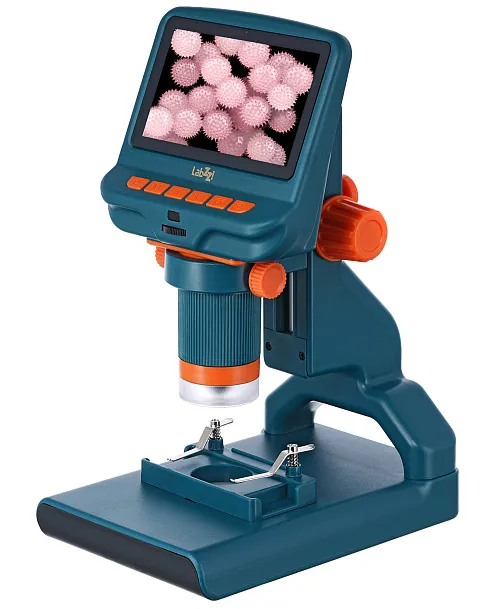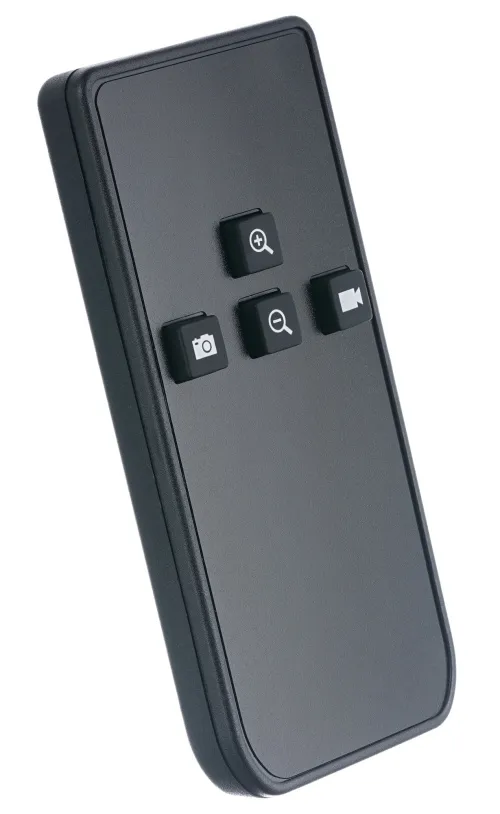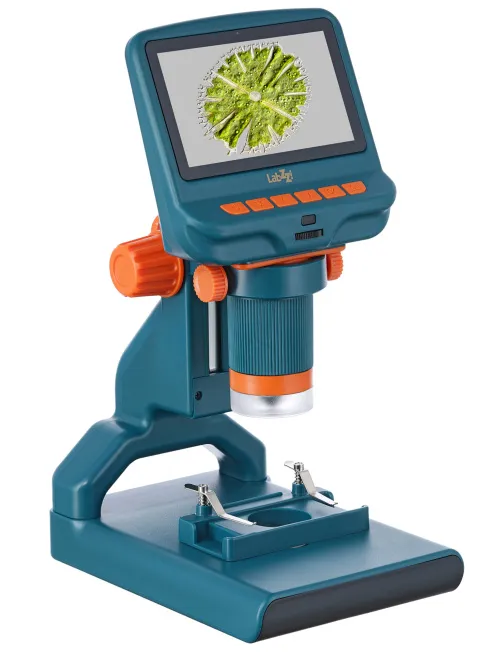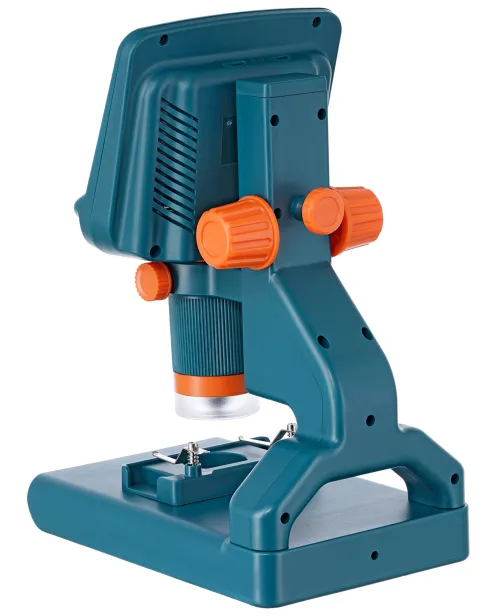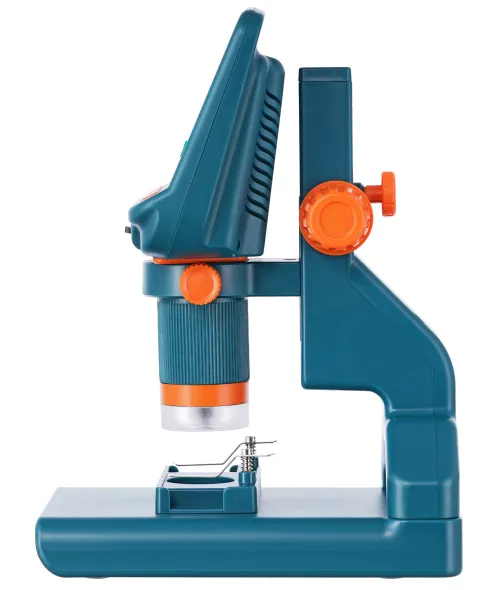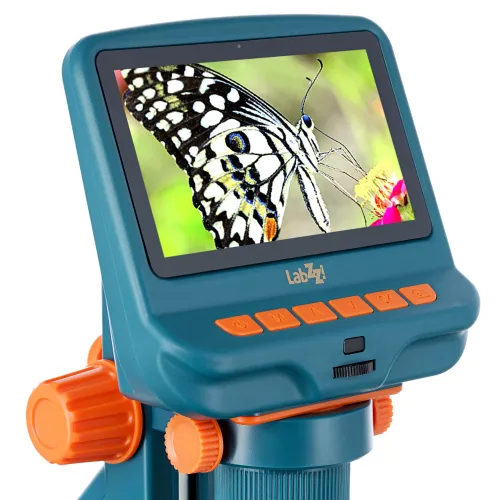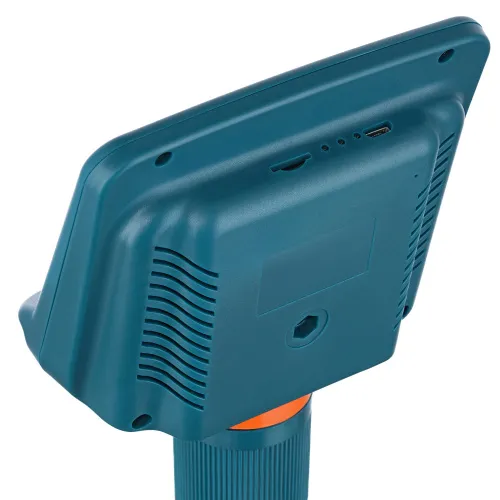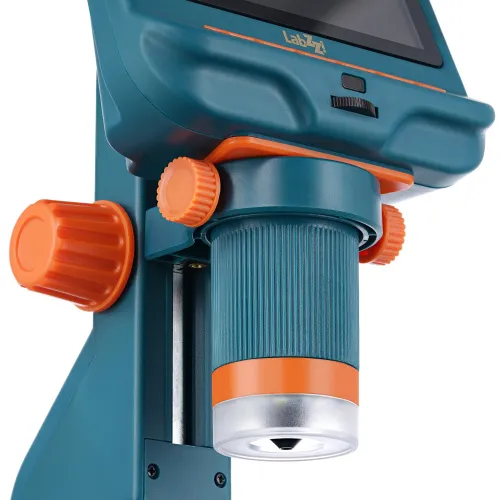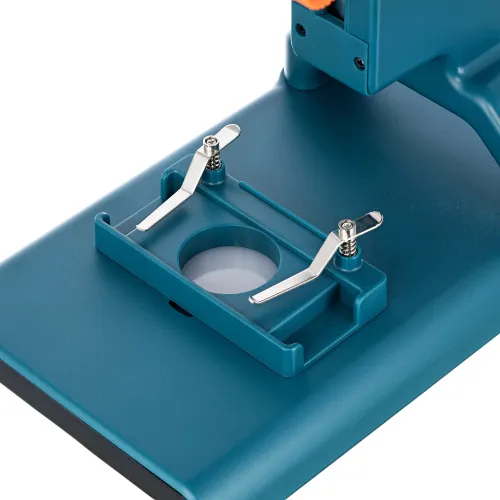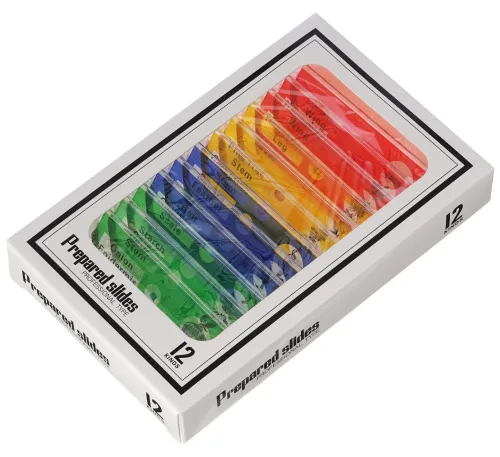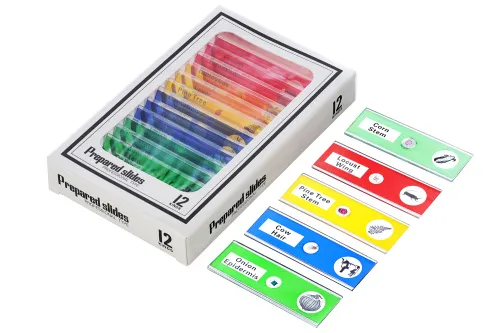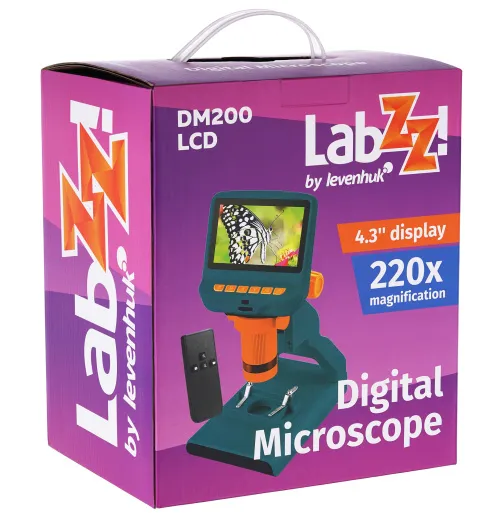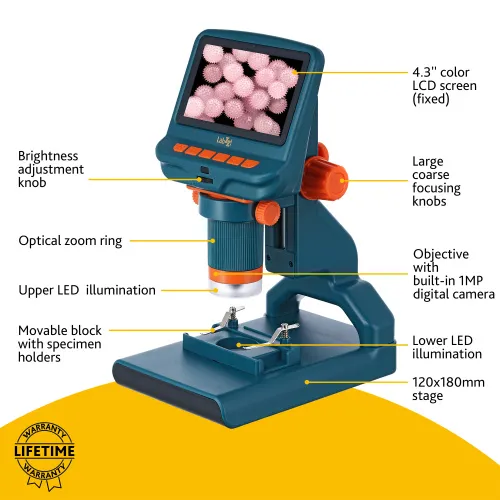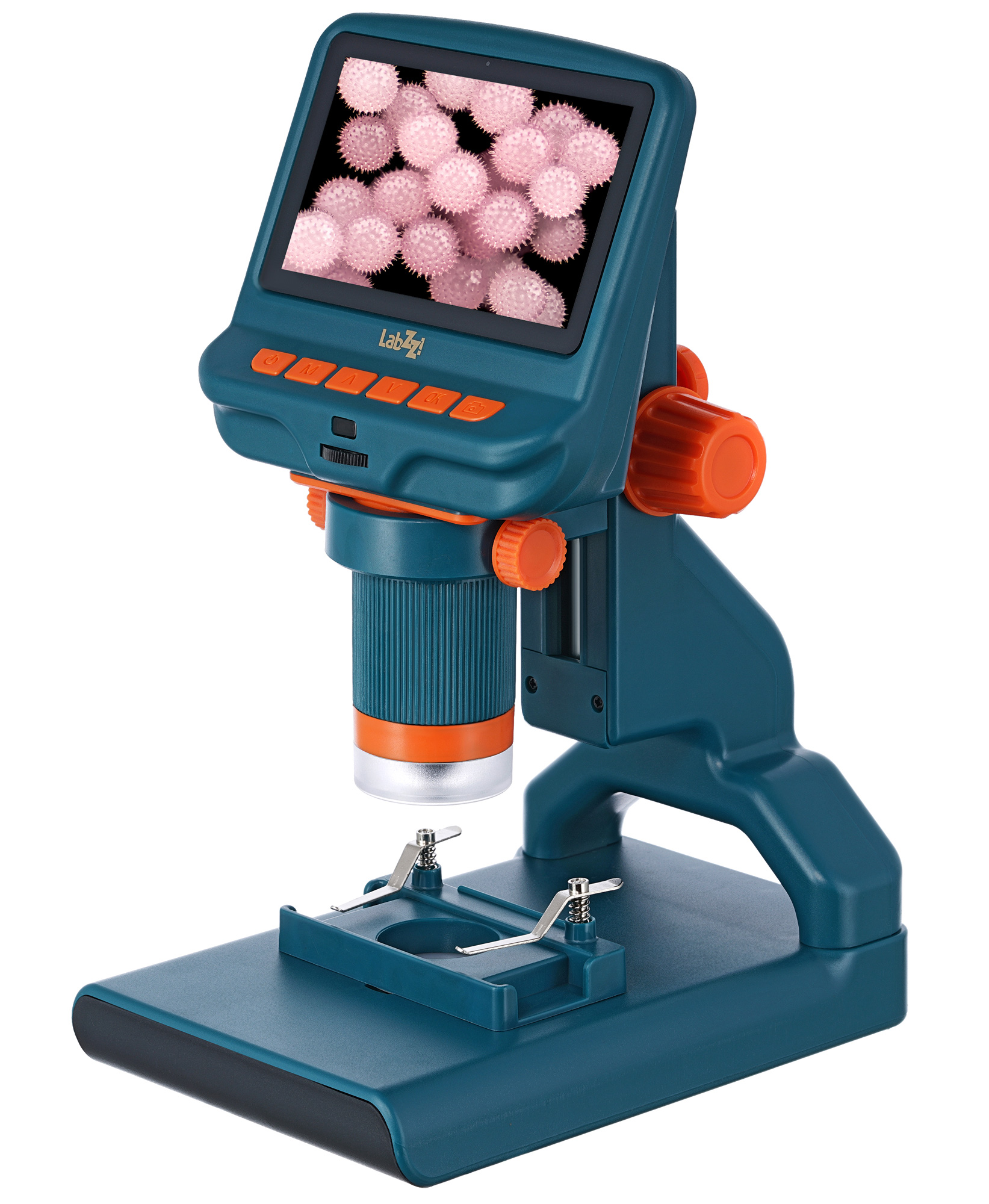Levenhuk LabZZ DM200 LCD Digital Microscope
Remote controlled. Magnification: 17–220 (digital), 17–55 (optical)
| Product ID | 76827 |
| Brand | Levenhuk, Inc., USA |
| Warranty | lifetime |
| EAN | 5905555011516 |
| Package size (LxWxH) | 25x21x17 cm |
| Shipping Weight | 1.14 kg |
Levenhuk LabZZ DM200 LCD is a digital microscope with a bright and interesting design. A child will appreciate not only the optical but also the digital capabilities of this microscope. It allows you to photograph specimens, record videos of research, and display an image on a computer screen. You can use the microscope to study anything: ready-to-use microscope slides, stones, fabrics, insects, leaves, electronics, and small mechanisms. The microscope is a great assistant in a scientific hobby and studies.
The microscope features a color LCD screen. Its diagonal is 4.3 inches. The displayed image is colorful, contrast, and bright. The magnification varies from 17 to 220 times, the optical part provides magnification in the range from 17 to 55 times. You can display images on a computer monitor by connecting via a USB cable and using screen capture software. The microscope features two light sources: upper and lower LED lights. That allows you to examine samples of any degree of transparency. There is a brightness adjustment.
Images and videos are saved to a memory card (purchased separately). The image quality is high: you get up to 12Mpx images and Full HD videos. It is convenient that you can start capturing images and recording videos using a wireless remote control.
The microscope can be powered by a built-in battery, so it can be used away from a power outlet.
Features:
- 4.3" color LCD screen
- Image quality: 12Mpx, video quality: Full HD
- Dual LED light with brightness adjustment
- Can run on battery for 2.5 hours
- Remote control allows for capturing images and starting video recording
- The kit includes ready-to-use microscope slides
- Bright body is designed especially for children
The kit includes:
- Microscope with an LCD screen
- Stage with clips and blank slides
- Infrared remote control
- Ready-to-use microscope slides:
- Locust wing
- Honeybee wing
- Honeybee leg
- Laver
- Pine tree stem
- Carnation stem
- Canary feather
- Cow hair
- Goldfish scale
- Potato starch
- Corn stem
- Onion epidermis
- Power cable
- Network adapter
- USB cable
- User manual and lifetime warranty
| Product ID | 76827 |
| Brand | Levenhuk, Inc., USA |
| Warranty | lifetime |
| EAN | 5905555011516 |
| Package size (LxWxH) | 25x21x17 cm |
| Shipping Weight | 1.14 kg |
| Type | digital |
| Microscope head type | digital screen/PC monitor |
| Optics material | optical glass |
| Head | 4.3'' color LCD screen (fixed) |
| Magnification, x | 17 — 220 |
| Stage, mm | 120x180 |
| Stage moving range, mm | 83/43 |
| Stage features | with clips |
| Focus | coarse: 93mm |
| Body | plastic |
| Illumination | LED |
| Brightness adjustment | ✓ |
| Power supply | illumination and LCD screen: 110–220 V; 5 V, 1 A via a USB cable (included) or a 1800 mAh built-in battery; remote control: CR2025 battery - 1 pc. (not included) |
| Power supply: batteries/built-in battery | yes |
| Light source type | lower illumination and lighting inside the objective lens |
| Operating temperature range, °C | -20...+70 |
| Additional | battery life: 2.5 hours; charging time: about 20 hours |
| Ability to connect additional equipment | supports microSD memory cards up to 32GB |
| User level | elementary |
| Assembly and installation difficulty level | extremely simple |
| Application | elementary |
| Illumination location | dual |
| Research method | bright field |
| Experiment kit included | ✓ |
| Maximum resolution | image: 4032x3024 pixels; video: 1080 FHD 1920x1080 pixels |
| Megapixels | sensor: 1; image: 12 |
| Sensor element | 1/4" CMOS |
| Pixel size, μm | 3x3 |
| Video recording | yes |
| Image format | *.jpg |
| Video format | *.avi |
| Spectral range, nm | 410–1100 |
| White balance | manual |
| Exposure control | manual |
| Software, drivers | AMCAP (Windows 7/8), ViewPlayCap (Windows 10) |
| Output | microSD card slot, mini-USB |
| System requirements | Windows 7/8/10, Mac OS |
and downloads
We have gathered answers to the most frequently asked questions to help you sort things out
Find out why studying eyes under a microscope is entertaining; how insects’ and arachnids’ eyes differ and what the best way is to observe such an interesting specimen
Read this review to learn how to observe human hair, what different hair looks like under a microscope and what magnification is required for observations
Learn what a numerical aperture is and how to choose a suitable objective lens for your microscope here
Learn what a spider looks like under microscope, when the best time is to take photos of it, how to study it properly at magnification and more interesting facts about observing insects and arachnids
This review for beginner explorers of the micro world introduces you to the optical, illuminating and mechanical parts of a microscope and their functions
Short article about Paramecium caudatum - a microorganism that is interesting to observe through any microscope

